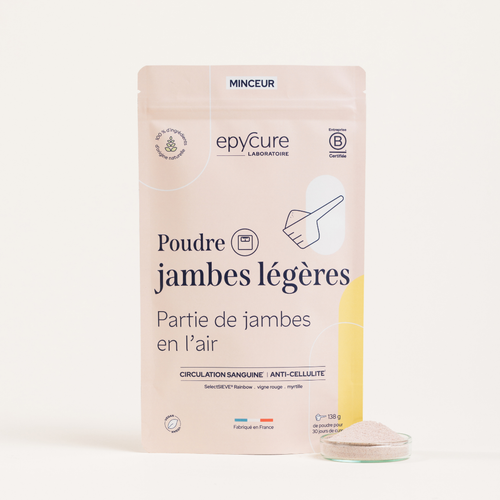With the arrival of summer and sunshine, we only have one thing on our minds: getting our skirts and dresses out of the closet !
Unfortunately, heavy legs and cellulite are common concerns that prevent you from feeling good about yourself. Mainly affecting women , these problems are not only aesthetic, they can be the result of deeper causes , and impact your health in the longer term.
We help you understand where they come from and how to fix them.
Understanding the heavy legs effect
When we talk about heavy legs, we often refer to the feeling of heaviness or fatigue weighing down our lower limbs. Unfortunately, this sensation doesn't stop there and can be accompanied by pain, cramps, varicose veins, swelling, and even edema.
There are many causes: high heat, prolonged standing, a sedentary lifestyle, an unbalanced diet, hormones, genetics , or even malformations. They can be the cause of a disruption in blood circulation , causing a slowdown in blood flow, which is specific to the feeling of heaviness. Due to gravity and prolonged standing, venous return to the heart is difficult in the legs, which is why this heaviness mainly affects the lower limbs.
Orange peel skin sets in
Cellulite is a metabolic skin disorder located in the subcutaneous tissue of the lower limbs and abdomen. Associated with female hormones, it affects up to 80% of women after puberty. Other factors will influence its appearance such as obesity or menopause, it is still important to differentiate the two, because cellulite can appear without a feeling of heavy legs, and vice versa .
Causes and areas affected by cellulite
Adipose cellulite is characterized by large adipocytes - cells specialized in the metabolism and storage of fat - present in specific areas of the body: the pelvis, buttocks, thighs, abdomen and, more rarely, the arms. Fibrous cellulite, on the other hand, involves the collagen fibers in our skin which will stretch the skin, thus creating the wavy appearance of the skin . These two types will sometimes intermingle and form mixed cellulite.
Indeed, the collagen fibers will be weakened by the accumulation of fat cells, adipocytes, which easily push towards the surface of the skin due to the positioning of the fibers and their rigidity. They end up taking up so much space that they will prevent the drainage of waste from the body , thus creating inflammation. This inflammation will be the cause of the bumpy appearance of the skin, called orange peel.
The manifestation of this type of cellulite is multifactorial, always linked to a normal (or not) accumulation of fat in certain specific areas of the body :
Hormonal cause
Estrogens are female sex hormones that play a crucial role in the body, particularly in the distribution of body fat . Throughout a woman's life, many hormonal changes will alter the impact of estrogen on the body: puberty, pregnancy, menstrual cycles, menopause , or even taking hormonal contraception.
Under the influence of these hormones, the storage of fat in the buttocks, hips and thighs is encouraged, thus causing the skin and collagen fibers to stretch, causing cellulite to appear.
Genetic cause
Genetics influence the appearance of cellulite. There is no specific "cellulite gene" ; other genetic mechanisms affect fat distribution, blood circulation, and connective tissue structure, which can influence its appearance.
If someone in your family has a history of cellulite , then there is a good chance that you will be susceptible to developing it .
Lifestyle
A diet rich in fats and sugars , insufficient physical activity or even excessive salt consumption will influence the appearance of cellulite. A sedentary lifestyle leads to the development of metabolic disorders such as obesity, which will be accelerated by a higher than normal level of cortisol (stress hormone), contributing to a higher risk of fat accumulation .
Functional anomalies
Certain diseases such as lipoedema, causing an abnormal accumulation of fat under the skin, or malformations such as varicose veins, poor blood circulation and certain anomalies of the connective tissue will be at the origin of the appearance of the orange peel effect. Indeed, they will play on an accumulation of toxins and liquids , most often in the lower limbs, thus contributing to the aggravation of cellulite .
Link between orange peel skin and heavy legs
There is a close link between the feeling of heavy legs and cellulite . In fact, these two disorders are linked to poor blood and lymphatic circulation . With reduced blood flow, the legs become heavier and tend to swell. This swelling will put pressure on the skin tissues, thus causing the orange peel effect of cellulite .
How to get rid of heavy legs and cellulite?
Many techniques are being developed to treat orange peel skin, but what is the reality? Is there a solution to reduce it, or even eliminate it?
Setting up an anti-heavy legs routine
To restore good blood circulation, there are massage and lymphatic drainage techniques. Physical exercise such as walking, swimming or cycling will also be beneficial. Combining it with a cold shower will further help tone your vessels, thus stimulating circulation .
Aesthetic medicine treatments
Cryotherapy
This cold remodeling technique acts on the death of fat cells by creating an inflammatory reaction in these tissues . Numerous studies have proven its effectiveness in reducing subcutaneous fat and therefore, indirectly, on cellulite.
Radio frequency
A reverse technique of cryotherapy, radiofrequency will raise the temperature on a targeted area to stimulate collagenase, the enzyme that produces collagen, and trigger lipolysis, allowing the breakdown of fats .
Laser
Depending on the wavelength chosen, the laser will emit energy into the skin, stimulating collagen remodeling and microcirculation . Without impacting fat cells, it will help reduce the appearance of cellulite by improving the appearance of the skin and venous circulation.
Food supplements
Formulated with plant extracts, vitamins or minerals , dietary supplements help relieve circulatory discomfort. Indeed, numerous studies have been conducted on certain plants for their benefits on blood circulation, skin elasticity or even the reduction of fat in the body.
The red vine
Red vine marc acts on multiple factors responsible for heavy legs and cellulite. It helps minimize fat accumulation and promotes good venous circulation by reducing blood pressure and inflammation. Its added bonus? It also plays a role in the integrity of collagen by strengthening its fibers and increasing its synthesis .
Blueberry
According to a study carried out in 2022, blueberry has demonstrated its benefits on microcirculation disorders and venous insufficiency [1]. It would reduce symptoms linked to circulatory disorders, in particular edema, cramps and even paresthesia.
SelectSIEVE®Rainbow: kiwi, orange, black rice & pineapple
A synergy of black rice, kiwi, pineapple and orange extracts, SelectSIEVE®Rainbow has proven its effectiveness in improving blood circulation , reducing cellulite , as well as firming and elasticizing the skin. Combined together, these four active ingredients form a unique complex to prevent and reduce heaviness and the appearance of cellulite.
Choose the Light Leg Powder
Light Legs Powder is a 100% natural treatment , with a red fruit flavor, which will help you regain more lightness in your daily life while contributing to refined and firmer legs .
This dual action is made possible by the synergy of blueberry, red vine, and the patented SelectSIEVE®Rainbow active ingredient. From the first few weeks, you'll notice effects on the feeling of heavy legs for more lightness in your daily life. However, to significantly reduce cellulite, it is recommended to follow the treatment for 3 months.
SelectSIEVE®Rainbow is a registered trademark of ROELMI HPC SRL.
[1] Study by Vaneková Z. and Rollinger J., Bilberries: Curative and Miraculous - A Review on Bioactive Constituents and Clinical Research, 2022.



